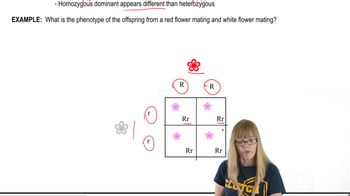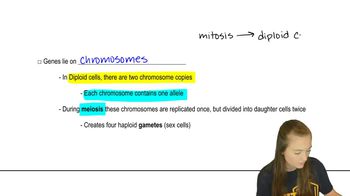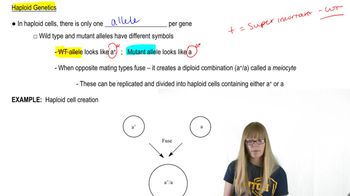Table of contents
- 1. Introduction to Genetics51m
- 2. Mendel's Laws of Inheritance3h 37m
- 3. Extensions to Mendelian Inheritance2h 41m
- 4. Genetic Mapping and Linkage2h 28m
- 5. Genetics of Bacteria and Viruses1h 21m
- 6. Chromosomal Variation1h 48m
- 7. DNA and Chromosome Structure56m
- 8. DNA Replication1h 10m
- 9. Mitosis and Meiosis1h 34m
- 10. Transcription1h 0m
- 11. Translation58m
- 12. Gene Regulation in Prokaryotes1h 19m
- 13. Gene Regulation in Eukaryotes44m
- 14. Genetic Control of Development44m
- 15. Genomes and Genomics1h 50m
- 16. Transposable Elements47m
- 17. Mutation, Repair, and Recombination1h 6m
- 18. Molecular Genetic Tools19m
- 19. Cancer Genetics29m
- 20. Quantitative Genetics1h 26m
- 21. Population Genetics50m
- 22. Evolutionary Genetics29m
2. Mendel's Laws of Inheritance
Inheritance in Diploids and Haploids
Problem 6a
Textbook Question
A couple and some of their relatives are screened for Gaucher disease in a community-based screening program. The woman is homozygous for the dominant allele, represented by G. The woman's father, sister, and paternal grandmother are heterozygous carriers of the mutant allele, represented by g. Her paternal grandfather, her mother, and both of her mother's parents are homozygous for the dominant allele. The man is heterozygous and he has a brother with Gaucher disease. The man's parents and grandparents have not been tested, but it is known that none of them has Gaucher disease.
Explain why you are able to assign genotypes to the man's parents despite their not being tested.
 Verified step by step guidance
Verified step by step guidance1
<span>Step 1: Understand the inheritance pattern of Gaucher disease. It is an autosomal recessive disorder, meaning that an individual must inherit two copies of the recessive allele (g) to express the disease.</span>
<span>Step 2: Analyze the man's genotype. He is heterozygous (Gg), meaning he carries one dominant allele (G) and one recessive allele (g). His brother has Gaucher disease, indicating the brother's genotype is homozygous recessive (gg).</span>
<span>Step 3: Determine the possible genotypes of the man's parents. Since the brother has Gaucher disease (gg), each parent must have contributed one recessive allele (g) to him. Therefore, both parents must be carriers, making their genotypes heterozygous (Gg).</span>
<span>Step 4: Consider the information about the man's grandparents. None of them has Gaucher disease, which suggests that they are either homozygous dominant (GG) or heterozygous (Gg). However, this information is not necessary to determine the parents' genotypes.</span>
<span>Step 5: Conclude that the man's parents are heterozygous carriers (Gg) because they must each carry one recessive allele (g) to have a child with Gaucher disease (gg).</span>
Recommended similar problem, with video answer:
 Verified Solution
Verified SolutionThis video solution was recommended by our tutors as helpful for the problem above
Video duration:
4mPlay a video:
Was this helpful?
Key Concepts
Here are the essential concepts you must grasp in order to answer the question correctly.
Dominant and Recessive Alleles
In genetics, alleles can be classified as dominant or recessive. A dominant allele, represented by a capital letter (e.g., G), will express its trait even if only one copy is present. In contrast, a recessive allele (e.g., g) requires two copies to express the trait. Understanding this distinction is crucial for determining genotypes based on phenotypic expressions in family members.
Recommended video:
Guided course

Variations on Dominance
Homozygosity and Heterozygosity
Homozygosity refers to having two identical alleles for a particular gene (e.g., GG or gg), while heterozygosity means having two different alleles (e.g., Gg). In the context of the question, knowing that the woman is homozygous dominant (GG) and the man is heterozygous (Gg) helps infer the genotypes of their relatives based on their phenotypes and inheritance patterns.
Recommended video:
Guided course

Hardy Weinberg
Inheritance Patterns
Inheritance patterns describe how traits and genetic conditions are passed from parents to offspring. In this case, Gaucher disease is an autosomal recessive condition, meaning that an individual must inherit two copies of the recessive allele (gg) to express the disease. By analyzing the genotypes of the couple and their relatives, one can deduce the genotypes of the man's parents based on the presence of the disease in his brother.
Recommended video:
Guided course

Organelle Inheritance

 27:36m
27:36mWatch next
Master Diploid Genetics with a bite sized video explanation from Kylia Goodner
Start learningRelated Videos
Related Practice



